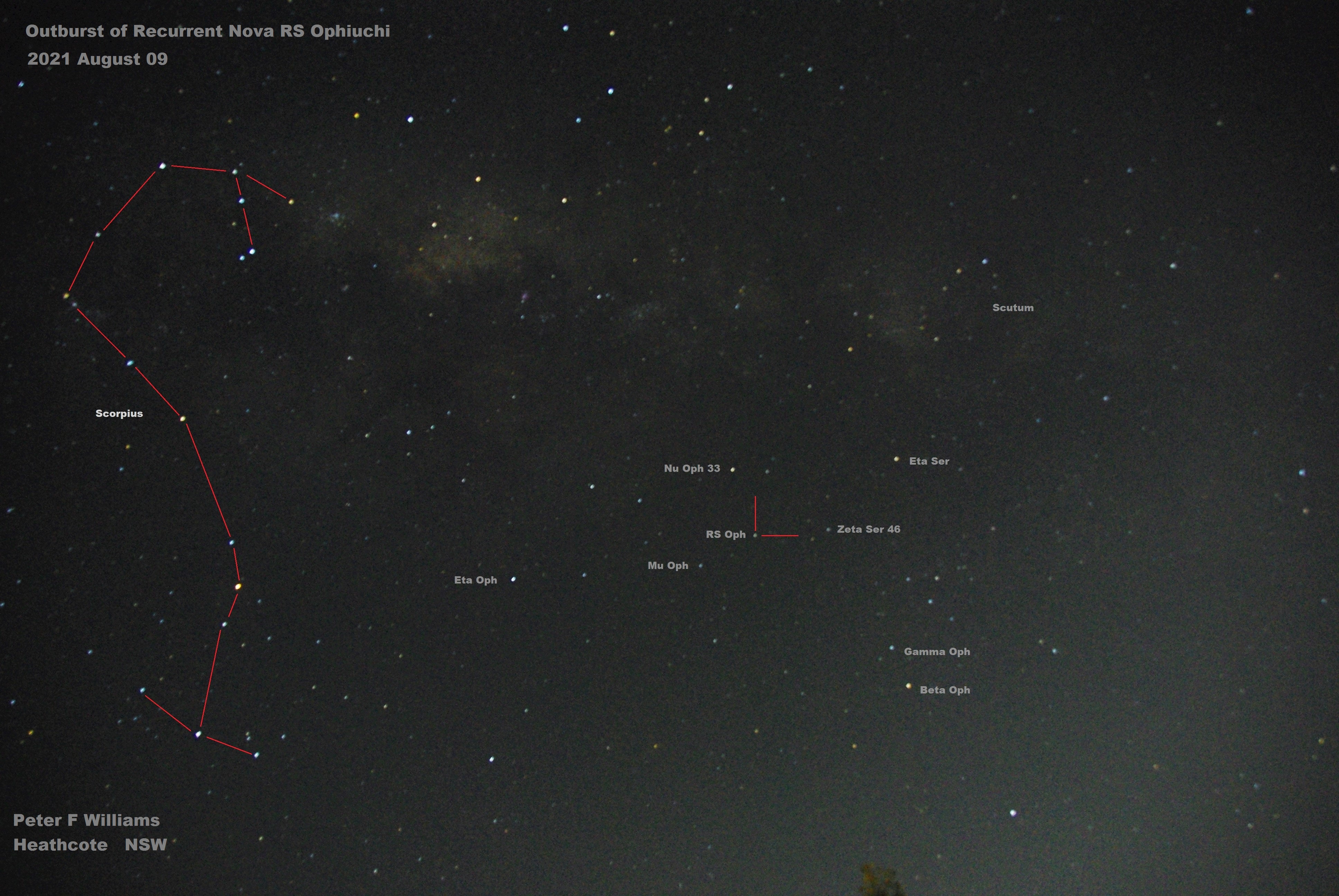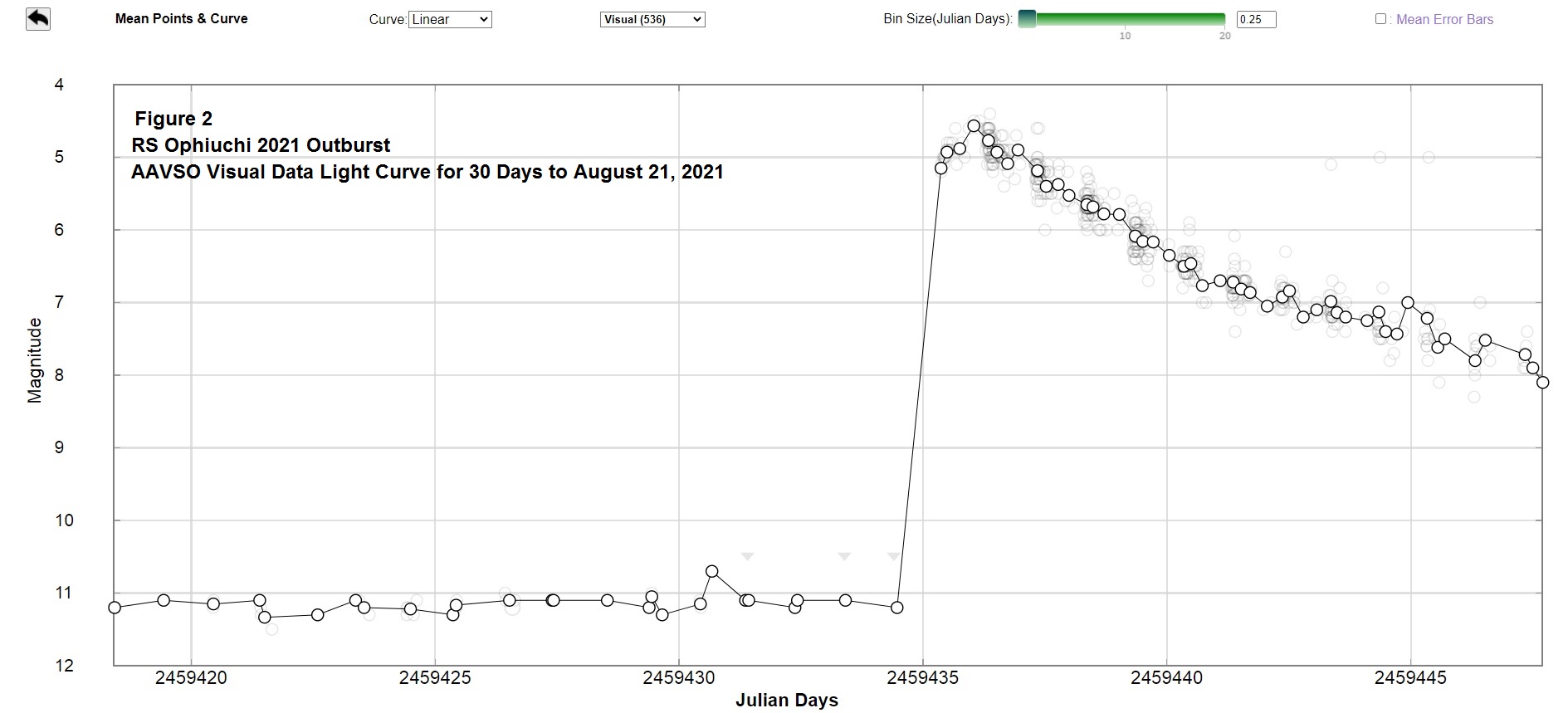RS Ophiuchi – A Recurrent Nova Outburst
In the early days of August 2021 the star RS Ophiuchi (abbreviated RS Oph) erupted in the evening sky. At maximum brightness RS Oph reached magnitude 4.5, bringing it within visibility of the unaided eye from relatively dark suburban locations.
This eruption was first detected by Juan Manzorro of Spain & Attila Kosa-Kiss of Romania, then Alexandre Amorim in Brazil followed by Eddy Muyllaert in Belgium and Keith Geary of Ireland, then a host of other observers world-wide as the Earth’s rotation brought darkness westward around the globe and news of the outburst detection quickly spread within the astronomical community via the internet. And as usually occurs with closely monitored stars such as RS Oph, a number of pre-discovery measures have since come to the fore.
It is, of course, wonderful to note this eruption of RS Oph was detected by amateur astronomers using just their eyes with binoculars or small telescopes in a time when a number of professional institutions are conducting all-sky surveys with arrays of electronic CCD detectors monitoring almost the whole sky. This is a tribute to these Citizen Scientists who regularly monitor variable stars such as RS Oph and who can provide “instant” notification of unusual or unexpected stellar behaviour.

The 2021 eruption of RS Oph is not the first outburst observed in this star. In fact, RS Oph is one of the more active members of a rare group of stars classified as Recurrent Novae (NR) of which there are just 10 currently recognised examples with our Milky Way galaxy, plus some examples within the nearby Large Magellanic Cloud (LMC) and the Andromeda Galaxy (NGC224 = M31).
The classification of variable stars is a somewhat inexact science and the particular group of variable stars to which any particular star is assigned can be somewhat “fluid” based on updated observation data that can see a star be assigned then reassigned over time.
The Recurrent Novae are loosely described as stars that have been observed to undergo more than one nova outburst. These outbursts are, however, of somewhat smaller amplitude and less energetic that those of the classical galactic novae and may occur at intervals of a decade to 80 or so years.
When between outbursts, these stars can show small amplitude semi regular variations on time scales of tens to several hundred days, flickering on time scales of minutes to tens of minutes, and/or eclipses.
The gross and small variations have their origins with the physical of the star. The first and perhaps most important feature is what we see as single star to the eye or through a telescope is actually two stars in orbit about a common centre of gravity. All novae and cataclysmic variable stars are binary systems typically comprising an evolved red giant secondary star in orbit with a more massive compact white dwarf. The red giant is losing material from its outer atmosphere during pulsations typical of these evolved stars and this is drawn by the strong gravitational pull of the white dwarf, forming a disc around the white dwarf.
Material from this disc is then drawn onto the surface of the white dwarf where it accumulates over time until a critical mass is reached and it ignites in a runaway nuclear reaction, expelling some of the accumulated material from the white dwarf and releasing enormous amounts of energy that we see a the nova outburst.
Interestingly, RS Oph first came the attention of astronomers when its variability was recognised in 1901 as a faint star showing irregular small amplitude fluctuations around magnitude 11 and during follow-up investigation it was shown to display a spectrum similar to the novae. A check was made on the photographic plate collection of the Harvard College Observatory from which it was found a bright outburst had occurred in 1898 but passed unnoticed by astronomers.
The current 2021 outburst brings to 9 the total number of eruptions detected in RS Oph. The interval between consecutive events is far from regular, however, ranging from 9 to 26 years.
During an outburst the rise from its normal state at minimum to peak brightness takes a little over 1 day, an amazing increase of 6 magnitudes or about 250 times in brightness. Maximum brightness is maintained for a comparatively short time and the light output begins to fall almost immediately, quickly at first but then at a more gradual rate as the outburst progresses and the star returns to near the pre-outburst level.
The light curve of each observed outburst has been remarkably similar and during the 2021 outburst RS Oph has faded 3.2 magnitudes in the first 10 days after maximum. This rate of 0.32 magnitude/day is in good agreement with previous eruptions. It is expected the rate of decline will gradually slow and a magnitude of 10.5 will be reached by 80 days from maximum. The full return to its pre-outburst state will take about 4 months.

As can be seen in the light curve produced via the AAVSO Light Curve Generator and shown in Figure 2, the outburst is still in progress at the time of writing so we will just have to wait and see if this behaviour does indeed repeat during this 2021 eruption.
Posted with STEMGeeks
Congratulations @pfwaus! You received a personal badge!
You can view your badges on your board and compare yourself to others in the Ranking